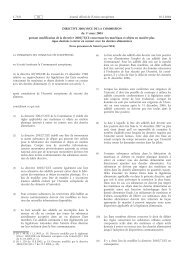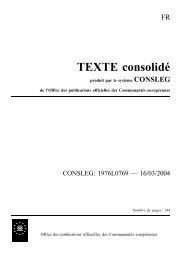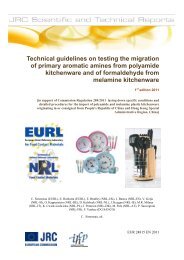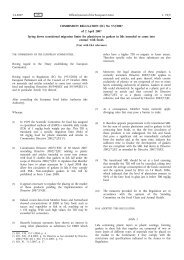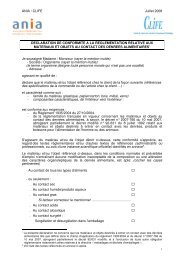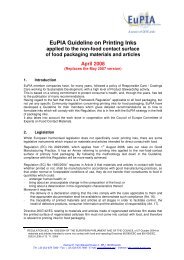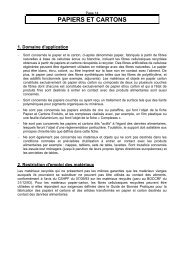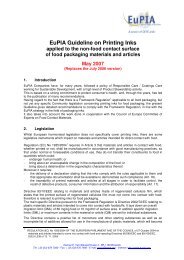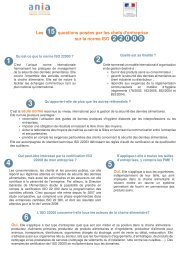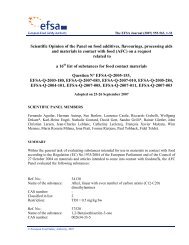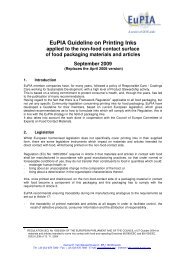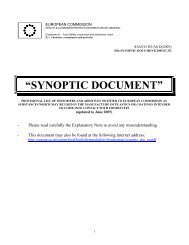Opinion of the Scientific Panel on Food Additives, Flavourings ...
Opinion of the Scientific Panel on Food Additives, Flavourings ...
Opinion of the Scientific Panel on Food Additives, Flavourings ...
Create successful ePaper yourself
Turn your PDF publications into a flip-book with our unique Google optimized e-Paper software.
The EFSA Journal (2004)65, 1-17<str<strong>on</strong>g>Opini<strong>on</strong></str<strong>on</strong>g> <str<strong>on</strong>g>of</str<strong>on</strong>g> <str<strong>on</strong>g>the</str<strong>on</strong>g> <str<strong>on</strong>g>Scientific</str<strong>on</strong>g> <str<strong>on</strong>g>Panel</str<strong>on</strong>g> <strong>on</strong> <strong>Food</strong> <strong>Additives</strong>,<strong>Flavourings</strong>, Processing Aids and Materials in C<strong>on</strong>tact with <strong>Food</strong> (AFC)<strong>on</strong> a request from <str<strong>on</strong>g>the</str<strong>on</strong>g> Commissi<strong>on</strong> related toa 4 th list <str<strong>on</strong>g>of</str<strong>on</strong>g> substances for food c<strong>on</strong>tact materials(Questi<strong>on</strong> N° EFSA-Q-2003-210, EFSA-Q-2003-223, EFSA-Q-2003-187,EFSA-Q-2003-202, EFSA-Q-2003-203)adopted <strong>on</strong> 26 May 2004 by written procedureSUMMARYWithin <str<strong>on</strong>g>the</str<strong>on</strong>g> general task <str<strong>on</strong>g>of</str<strong>on</strong>g> evaluating substances intended for use in materials in c<strong>on</strong>tact with foodaccording to Council Directive 89/109/EEC <str<strong>on</strong>g>of</str<strong>on</strong>g> 21 December 1988 relating to materials and articlesintended to come into c<strong>on</strong>tact with foodstuffs, <str<strong>on</strong>g>the</str<strong>on</strong>g> AFC <str<strong>on</strong>g>Panel</str<strong>on</strong>g> evaluated <str<strong>on</strong>g>the</str<strong>on</strong>g> following substances.Ref. No.: 13317Name <str<strong>on</strong>g>of</str<strong>on</strong>g> <str<strong>on</strong>g>the</str<strong>on</strong>g> substance: N,N'-Bis[4-(ethoxycarb<strong>on</strong>yl)phenyl]-1,4,5,8-naphthalenetetracarboxydiimideCAS number: 132459-54-2Classified in list: 3Restricti<strong>on</strong>:0.05 mg/kg foodRef. No.: 25540Name <str<strong>on</strong>g>of</str<strong>on</strong>g> <str<strong>on</strong>g>the</str<strong>on</strong>g> substance: Trimellitic acidCAS number: 528-44-9Classified in list: 3Restricti<strong>on</strong>:5 mg/kg foodRef. No.: 25550Name <str<strong>on</strong>g>of</str<strong>on</strong>g> <str<strong>on</strong>g>the</str<strong>on</strong>g> substance: Trimellitic anhydrideCAS number: 552-30-7Classified in list: 3Restricti<strong>on</strong>:5 mg/kg food, expressed as trimellitic acidRef. No.: 66930Name <str<strong>on</strong>g>of</str<strong>on</strong>g> <str<strong>on</strong>g>the</str<strong>on</strong>g> substance: MethylsilsesquioxaneCAS number: 68554-70-1Classified in list: 3Restricti<strong>on</strong>:Residual m<strong>on</strong>omer in methylsilsesquioxane: < 1 mgmethyltrimethoxysilane/kg <str<strong>on</strong>g>of</str<strong>on</strong>g> methylsilsesquioxaneRef. No.: 86432
4 th list <str<strong>on</strong>g>of</str<strong>on</strong>g> substances for food c<strong>on</strong>tact materials The EFSA Journal (2004)65Name <str<strong>on</strong>g>of</str<strong>on</strong>g> <str<strong>on</strong>g>the</str<strong>on</strong>g> substance: Silver-c<strong>on</strong>taining glass (Silver-magnesium-calcium-phosphateborate)CAS number: -Classified in list: 3Restricti<strong>on</strong>:Group restricti<strong>on</strong> <str<strong>on</strong>g>of</str<strong>on</strong>g> 0.05 mg Ag/kg foodRef. No.: 86434Name <str<strong>on</strong>g>of</str<strong>on</strong>g> <str<strong>on</strong>g>the</str<strong>on</strong>g> substance: Silver sodium hydrogen zirc<strong>on</strong>ium phosphateCAS number: -Classified in list: 3Restricti<strong>on</strong>:Group restricti<strong>on</strong> <str<strong>on</strong>g>of</str<strong>on</strong>g> 0.05 mg Ag/kg foodKEY WORDS<strong>Food</strong> C<strong>on</strong>tact Materials, Plastics, M<strong>on</strong>omers, <strong>Additives</strong>, N,N'-Bis[4-(ethoxycarb<strong>on</strong>yl)phenyl]-1,4,5,8-naphthalenetetracarboxydiimide, REF. No 13317, CAS No 132459-54-2, Trimellitic acid,REF. No 25540, CAS No 528-44-9, Trimellitic anhydride, REF. No 25550, CAS No 552-30-7,Methylsilsesquioxane, REF. No 66930, CAS No 68554-70-1, Silver-c<strong>on</strong>taining glass (Silvermagnesium-calcium-phosphate-borate),REF. No 86432, Silver sodium hydrogen zirc<strong>on</strong>iumphosphate, REF. No 86434.BACKGROUNDAccording to Article 3(3) <str<strong>on</strong>g>of</str<strong>on</strong>g> <str<strong>on</strong>g>the</str<strong>on</strong>g> Council Directive 89/109/EEC <str<strong>on</strong>g>of</str<strong>on</strong>g> 21 December 1988 it isnecessary to c<strong>on</strong>sult <str<strong>on</strong>g>the</str<strong>on</strong>g> <str<strong>on</strong>g>Scientific</str<strong>on</strong>g> Committee <strong>on</strong> <strong>Food</strong> (SCF) <strong>on</strong> <str<strong>on</strong>g>the</str<strong>on</strong>g> risks c<strong>on</strong>nected with <str<strong>on</strong>g>the</str<strong>on</strong>g>migrati<strong>on</strong> <str<strong>on</strong>g>of</str<strong>on</strong>g> substances into food from food c<strong>on</strong>tact materials in which <str<strong>on</strong>g>the</str<strong>on</strong>g>y are used. Thiscompetence was transferred to <str<strong>on</strong>g>the</str<strong>on</strong>g> European <strong>Food</strong> Safety Authority (EFSA) by virtue <str<strong>on</strong>g>of</str<strong>on</strong>g> <str<strong>on</strong>g>the</str<strong>on</strong>g>Regulati<strong>on</strong> (EC) 178/2002.The opini<strong>on</strong> <str<strong>on</strong>g>of</str<strong>on</strong>g> <str<strong>on</strong>g>the</str<strong>on</strong>g> EFSA is required before a substance is authorised tobe used in food c<strong>on</strong>tact materials and be included in a positive list when this is established in <str<strong>on</strong>g>the</str<strong>on</strong>g>relevant legislati<strong>on</strong>.TERMS OF REFERENCEThe Commissi<strong>on</strong> asks EFSA to carry out risk assessments <strong>on</strong>:1. all new substances used in food c<strong>on</strong>tact materials before <str<strong>on</strong>g>the</str<strong>on</strong>g>ir authorisati<strong>on</strong> and inclusi<strong>on</strong> ina positive list;2. substances which are already authorised in <str<strong>on</strong>g>the</str<strong>on</strong>g> framework <str<strong>on</strong>g>of</str<strong>on</strong>g> Council Directive 89/109/EECbut need to be re-evaluated.ASSESSMENTWithin this general task <str<strong>on</strong>g>the</str<strong>on</strong>g> <str<strong>on</strong>g>Scientific</str<strong>on</strong>g> <str<strong>on</strong>g>Panel</str<strong>on</strong>g> <strong>on</strong> <strong>Food</strong> <strong>Additives</strong>, <strong>Flavourings</strong>, Processing Aids andMaterials in C<strong>on</strong>tact with <strong>Food</strong> (AFC) (re)evaluated three substances used as additives in foodc<strong>on</strong>tact materials. The substances examined are listed in ascending order <str<strong>on</strong>g>of</str<strong>on</strong>g> <str<strong>on</strong>g>the</str<strong>on</strong>g>ir Reference Number(REF No.), with <str<strong>on</strong>g>the</str<strong>on</strong>g>ir chemical name, Chemical Abstract Number (CAS No.) and classificati<strong>on</strong>according to <str<strong>on</strong>g>the</str<strong>on</strong>g> “SCF list”. (Previously <str<strong>on</strong>g>the</str<strong>on</strong>g> evaluati<strong>on</strong> <str<strong>on</strong>g>of</str<strong>on</strong>g> substances used in food c<strong>on</strong>tact materialswas undertaken by <str<strong>on</strong>g>the</str<strong>on</strong>g> <str<strong>on</strong>g>Scientific</str<strong>on</strong>g> Committee <strong>on</strong> <strong>Food</strong> (SCF).) The definiti<strong>on</strong>s <str<strong>on</strong>g>of</str<strong>on</strong>g> <str<strong>on</strong>g>the</str<strong>on</strong>g> various SCFlists and <str<strong>on</strong>g>the</str<strong>on</strong>g> abbreviati<strong>on</strong>s used are given in <str<strong>on</strong>g>the</str<strong>on</strong>g> appendix.2
4 th list <str<strong>on</strong>g>of</str<strong>on</strong>g> substances for food c<strong>on</strong>tact materials The EFSA Journal (2004)65Ref. No.: 13317Name <str<strong>on</strong>g>of</str<strong>on</strong>g> <str<strong>on</strong>g>the</str<strong>on</strong>g> substance:N,N'-Bis[4-(ethoxycarb<strong>on</strong>yl)phenyl]-1,4,5,8-naphthalenetetracarboxydiimideCAS number: 132459-54-2Document reference: EFSA/AFC/FCM/135-Rev.IB/13317General informati<strong>on</strong>:Previous evaluati<strong>on</strong>s (bySCF or AFC):According to <str<strong>on</strong>g>the</str<strong>on</strong>g> petiti<strong>on</strong>er, N,N'-Bis[4-(ethoxycarb<strong>on</strong>yl)phenyl]-1,4,5,8-naphthalenetetracarboxydiimide (purity > 98.1%) is a co-m<strong>on</strong>omer (usedup to 4%) in polyester articles [poly(ethylene terephthalate),poly(butylene terephthalate)], to provide UV shielding properties.The substance was first evaluated in 2002 (SCF 2002) and it wasclassified in List 7The n<strong>on</strong>-toxicity data included:- data <strong>on</strong> identity, purity, chemical and physico-chemical behaviour, useand authorisati<strong>on</strong>- an estimati<strong>on</strong> <str<strong>on</strong>g>of</str<strong>on</strong>g> migrati<strong>on</strong> by a worst case calculati<strong>on</strong>- data <strong>on</strong> residual c<strong>on</strong>tent <str<strong>on</strong>g>of</str<strong>on</strong>g> <str<strong>on</strong>g>the</str<strong>on</strong>g> substance <str<strong>on</strong>g>of</str<strong>on</strong>g> <str<strong>on</strong>g>the</str<strong>on</strong>g> polymer, with a properlydescribed methodThe substance is used as a co-m<strong>on</strong>omer for polyesters (polymericadditives, PET and PBT). It is used at up to 4 % in <str<strong>on</strong>g>the</str<strong>on</strong>g> final article(usually 1 %) and gives str<strong>on</strong>g UV shielding properties. No reacti<strong>on</strong> nordegradati<strong>on</strong> products in food are expected. The maximum possiblemigrati<strong>on</strong> was calculated to be 15 µg/kg <str<strong>on</strong>g>of</str<strong>on</strong>g> food by determining <str<strong>on</strong>g>the</str<strong>on</strong>g>residual amount <str<strong>on</strong>g>of</str<strong>on</strong>g> <str<strong>on</strong>g>the</str<strong>on</strong>g> substance in <str<strong>on</strong>g>the</str<strong>on</strong>g> plastic, and assuming a 100 %migrati<strong>on</strong>, which is a very severe assumpti<strong>on</strong>. In <str<strong>on</strong>g>the</str<strong>on</strong>g> HPLC-UVchromatogram <str<strong>on</strong>g>of</str<strong>on</strong>g> <str<strong>on</strong>g>the</str<strong>on</strong>g> extracts supplied with <str<strong>on</strong>g>the</str<strong>on</strong>g> data <str<strong>on</strong>g>of</str<strong>on</strong>g> <str<strong>on</strong>g>the</str<strong>on</strong>g> firstevaluati<strong>on</strong>, an unidentified compound, in an unknown proporti<strong>on</strong>, wasdetected, which justified <str<strong>on</strong>g>the</str<strong>on</strong>g> request for additi<strong>on</strong>al informati<strong>on</strong>. This willbe discussed below.The toxicity data included:- a gene-mutati<strong>on</strong> assay in bacteria,- a chromosomal aberrati<strong>on</strong> test in cultured mammalian cells,- a gene-mutati<strong>on</strong> assay in cultured mammalian cells,- a micr<strong>on</strong>ucleus assay- a 28-day oral study in male and female rats (Sprague Dawley).In <str<strong>on</strong>g>the</str<strong>on</strong>g> chromosome aberrati<strong>on</strong> assay, <str<strong>on</strong>g>the</str<strong>on</strong>g> incidence <str<strong>on</strong>g>of</str<strong>on</strong>g> cells with numericalaberrant chromosomes increased significantly (up to 11 fold) and it wasdose-dependent in both 48-hour c<strong>on</strong>tinuous treatment and in <str<strong>on</strong>g>the</str<strong>on</strong>g> pulsetreatment when S9 mix was added.However, in a b<strong>on</strong>e marrow micr<strong>on</strong>ucleus test with <str<strong>on</strong>g>the</str<strong>on</strong>g> substance, <str<strong>on</strong>g>the</str<strong>on</strong>g> rate<str<strong>on</strong>g>of</str<strong>on</strong>g> micr<strong>on</strong>uclei was in <str<strong>on</strong>g>the</str<strong>on</strong>g> same range than negative c<strong>on</strong>trols and <str<strong>on</strong>g>the</str<strong>on</strong>g>PCE/NCE ratio was significantly affected <strong>on</strong>ly in males at <str<strong>on</strong>g>the</str<strong>on</strong>g> 24hsampling time, indicating that <str<strong>on</strong>g>the</str<strong>on</strong>g> substance did reach <str<strong>on</strong>g>the</str<strong>on</strong>g> target organ.3
4 th list <str<strong>on</strong>g>of</str<strong>on</strong>g> substances for food c<strong>on</strong>tact materials The EFSA Journal (2004)65Ref. No.: 13317Name <str<strong>on</strong>g>of</str<strong>on</strong>g> <str<strong>on</strong>g>the</str<strong>on</strong>g> substance: N,N'-Bis[4-(ethoxycarb<strong>on</strong>yl)phenyl]-1,4,5,8-naphthalenetetracarboxydiimideFrom <str<strong>on</strong>g>the</str<strong>on</strong>g>se in vitro and in vivo assays, it was c<strong>on</strong>cluded that <str<strong>on</strong>g>the</str<strong>on</strong>g> substancehas no genotoxic potency.In an acute oral toxicity study, <str<strong>on</strong>g>the</str<strong>on</strong>g> LD 50 was greater than 2000-mg/kg b.w.N,N'-Bis[4-(ethoxycarb<strong>on</strong>yl)phenyl]-1,4,5,8-naphthalenetetracarboxydiimide was administered, via <str<strong>on</strong>g>the</str<strong>on</strong>g> diet, toSprague-Dawley rats, at different doses (dose range: 0 to 1000 mg/kgb.w.) for 28 days. A 14-day recovery period experiment was performedfor c<strong>on</strong>trol and high dose. No examined parameter was significantlymodified. The NOEL is 1000 mg/kg b.w., based <strong>on</strong> <str<strong>on</strong>g>the</str<strong>on</strong>g> highest dosetested.The first evaluati<strong>on</strong> c<strong>on</strong>cluded that <str<strong>on</strong>g>the</str<strong>on</strong>g> data available were c<strong>on</strong>sistent witha migrati<strong>on</strong> limit 50 ppb. However, since c<strong>on</strong>cerns had been expressedabout <str<strong>on</strong>g>the</str<strong>on</strong>g> identity <str<strong>on</strong>g>of</str<strong>on</strong>g> <str<strong>on</strong>g>the</str<strong>on</strong>g> unknown compound co-eluted with <str<strong>on</strong>g>the</str<strong>on</strong>g> substancein <str<strong>on</strong>g>the</str<strong>on</strong>g> HPLC chromatogram, and its possible toxicity, it was decided torequest in first instance informati<strong>on</strong> <strong>on</strong> <str<strong>on</strong>g>the</str<strong>on</strong>g> nature, quantity and migrati<strong>on</strong><str<strong>on</strong>g>of</str<strong>on</strong>g> <str<strong>on</strong>g>the</str<strong>on</strong>g> co-eluted compound. Depending <strong>on</strong> its identity, additi<strong>on</strong>altoxicological data <strong>on</strong> this compound may later be required. The substancewas <str<strong>on</strong>g>the</str<strong>on</strong>g>refore classified in list 7.Available dataused for this evaluati<strong>on</strong>:N<strong>on</strong>-toxicity data: - New data <strong>on</strong> purity, with identificati<strong>on</strong> <str<strong>on</strong>g>of</str<strong>on</strong>g> impurities, and estimati<strong>on</strong> <str<strong>on</strong>g>of</str<strong>on</strong>g><str<strong>on</strong>g>the</str<strong>on</strong>g>ir possible migrati<strong>on</strong>- Adequate informati<strong>on</strong> about <str<strong>on</strong>g>the</str<strong>on</strong>g> unknown peakEvaluati<strong>on</strong>:C<strong>on</strong>clusi<strong>on</strong>:The purity <str<strong>on</strong>g>of</str<strong>on</strong>g> <str<strong>on</strong>g>the</str<strong>on</strong>g> co-m<strong>on</strong>omer has been completely re-investigated, usingmodern analytical methods (HPLC-UV and HPLC-MS), which allowed ac<strong>on</strong>vincing identificati<strong>on</strong> <str<strong>on</strong>g>of</str<strong>on</strong>g> <str<strong>on</strong>g>the</str<strong>on</strong>g> impurities. The new results are:<str<strong>on</strong>g>the</str<strong>on</strong>g> co-eluted peak is no l<strong>on</strong>ger detected, and a likely explanati<strong>on</strong> for thishas been given.Four impurities <str<strong>on</strong>g>of</str<strong>on</strong>g> <str<strong>on</strong>g>the</str<strong>on</strong>g> co-m<strong>on</strong>omer were identified, accounting for a total<str<strong>on</strong>g>of</str<strong>on</strong>g> 1.9 % (purity <str<strong>on</strong>g>of</str<strong>on</strong>g> <str<strong>on</strong>g>the</str<strong>on</strong>g> substance > 98.1%). These impurities becomecovalently bound to <str<strong>on</strong>g>the</str<strong>on</strong>g> polyester, and were not detected in a polyestermade from <str<strong>on</strong>g>the</str<strong>on</strong>g> co-m<strong>on</strong>omer (detecti<strong>on</strong> limits 2-10 mg/kg).The informati<strong>on</strong> package needed for safety assessment has thus beencompleted. The impurities <str<strong>on</strong>g>of</str<strong>on</strong>g> <str<strong>on</strong>g>the</str<strong>on</strong>g> substance are <str<strong>on</strong>g>of</str<strong>on</strong>g> no c<strong>on</strong>cern anymore, for<str<strong>on</strong>g>the</str<strong>on</strong>g> following reas<strong>on</strong>s:(i) <str<strong>on</strong>g>the</str<strong>on</strong>g>y have <str<strong>on</strong>g>the</str<strong>on</strong>g> same functi<strong>on</strong>al groups as <str<strong>on</strong>g>the</str<strong>on</strong>g> parent m<strong>on</strong>omer, andbecome covalently bound to <str<strong>on</strong>g>the</str<strong>on</strong>g> polymer (<str<strong>on</strong>g>the</str<strong>on</strong>g> impurities are indeed notdetected in <str<strong>on</strong>g>the</str<strong>on</strong>g> polymer),(ii) <str<strong>on</strong>g>the</str<strong>on</strong>g>ir migrati<strong>on</strong> into food could be predicted to be well below 1 µg/kgfood simulant and(iii) <str<strong>on</strong>g>the</str<strong>on</strong>g>ir chemical similarity with <str<strong>on</strong>g>the</str<strong>on</strong>g> parent compound suggested asimilar in vivo behaviourBased <strong>on</strong> <str<strong>on</strong>g>the</str<strong>on</strong>g> above data <str<strong>on</strong>g>the</str<strong>on</strong>g> substance is classified:SCF_List: 34
4 th list <str<strong>on</strong>g>of</str<strong>on</strong>g> substances for food c<strong>on</strong>tact materials The EFSA Journal (2004)65Ref. No.: 13317Name <str<strong>on</strong>g>of</str<strong>on</strong>g> <str<strong>on</strong>g>the</str<strong>on</strong>g> substance: N,N'-Bis[4-(ethoxycarb<strong>on</strong>yl)phenyl]-1,4,5,8-naphthalenetetracarboxydiimideRestricti<strong>on</strong>: 0.05 mg/kg foodRemark for Commissi<strong>on</strong>: FRF is applicableN,N'-Bis[4-(ethoxycarb<strong>on</strong>yl)phenyl]-1,4,5,8-naphthalenetetracarboxydiimide(> 98.1 %) is requested as a co-m<strong>on</strong>omer (max. 4 %) for polyesters (likePET, PBT).Needed data or informati<strong>on</strong>: N<strong>on</strong>eReferences:- Unpublished data submitted by <str<strong>on</strong>g>the</str<strong>on</strong>g> petiti<strong>on</strong>er- <str<strong>on</strong>g>Opini<strong>on</strong></str<strong>on</strong>g> <str<strong>on</strong>g>of</str<strong>on</strong>g> <str<strong>on</strong>g>the</str<strong>on</strong>g> <str<strong>on</strong>g>Scientific</str<strong>on</strong>g> Committee <strong>on</strong> <strong>Food</strong> <strong>on</strong> <str<strong>on</strong>g>the</str<strong>on</strong>g> 19th additi<strong>on</strong>al list<str<strong>on</strong>g>of</str<strong>on</strong>g> m<strong>on</strong>omers and additives for food c<strong>on</strong>tact materials expressed <strong>on</strong>September 2002http://europa.eu.int/comm/food/fs/sc/scf/out141_en.pdfRef. No.: 25540Name <str<strong>on</strong>g>of</str<strong>on</strong>g> <str<strong>on</strong>g>the</str<strong>on</strong>g> substance: Trimellitic acidCAS number: 528-44-9Document reference: SDS EFSA/AFC/FCM/84-Rev.1A/25540General informati<strong>on</strong>:Previous evaluati<strong>on</strong>s(by SCF or AFC):According to <str<strong>on</strong>g>the</str<strong>on</strong>g> petiti<strong>on</strong>er Trimellitic anhydride (TMA) is used asm<strong>on</strong>omer in epoxy resins for coatings and in polyamidimide.Polyamidimide is used as an anchoring agent for PTFE dispersi<strong>on</strong> polymers<strong>on</strong> various substrates. The finished products are used in high temperatureapplicati<strong>on</strong>s (backing and cooking). TMA modified coatings are applied incoatings and lining <str<strong>on</strong>g>of</str<strong>on</strong>g> cans and utensils; c<strong>on</strong>diti<strong>on</strong>s <str<strong>on</strong>g>of</str<strong>on</strong>g> c<strong>on</strong>tact will varyfrom l<strong>on</strong>g term storage at room temperature to sterilizati<strong>on</strong>.Trimellitic acid is <str<strong>on</strong>g>the</str<strong>on</strong>g> remaining acid after hydrolysis <str<strong>on</strong>g>of</str<strong>on</strong>g> trimelliticanhydride.The substance was first evaluated by SCF in 1998 and classified in List 7.Needed data: 90-day oral study.Available dataused for this evaluati<strong>on</strong>:N<strong>on</strong>-toxicity data: -Microbiological data: -Toxicity data: Data <strong>on</strong> 90-day oral studyEvaluati<strong>on</strong>:Specific migrati<strong>on</strong> <str<strong>on</strong>g>of</str<strong>on</strong>g> trimellitic acid into water, 3% acetic acid, 8, 15 or50% ethanol, n-heptane, olive oil or HB307 and iso-octane at a range <str<strong>on</strong>g>of</str<strong>on</strong>g>time/temperature c<strong>on</strong>diti<strong>on</strong>s has been determined. The test samples weretrimellitic anhydride-based epoxy powder coatings <strong>on</strong> support and5
4 th list <str<strong>on</strong>g>of</str<strong>on</strong>g> substances for food c<strong>on</strong>tact materials The EFSA Journal (2004)65Ref. No.: 25550Name <str<strong>on</strong>g>of</str<strong>on</strong>g> <str<strong>on</strong>g>the</str<strong>on</strong>g> substance: Trimellitic anhydrideCAS number: 552-30-7Document reference: EFSA/AFC/FCM/85-Rev.IA/25550General informati<strong>on</strong>:Previous evaluati<strong>on</strong>s(by SCF or AFC):According to <str<strong>on</strong>g>the</str<strong>on</strong>g> petiti<strong>on</strong>er Trimellitic anhydride (TMA) is used asm<strong>on</strong>omer in epoxy resins for coatings and in polyamidimide.Polyamidimide is used as an anchoring agent for PTFE dispersi<strong>on</strong> polymers<strong>on</strong> various substrates. The finished products are used in high temperatureapplicati<strong>on</strong>s (backing and cooking). TMA modified coatings are applied incoatings and lining <str<strong>on</strong>g>of</str<strong>on</strong>g> cans and utensils; c<strong>on</strong>diti<strong>on</strong>s <str<strong>on</strong>g>of</str<strong>on</strong>g> c<strong>on</strong>tact will varyfrom l<strong>on</strong>g term storage at room temperature to sterilizati<strong>on</strong>.Trimellitic acid is <str<strong>on</strong>g>the</str<strong>on</strong>g> remaining acid after hydrolysis <str<strong>on</strong>g>of</str<strong>on</strong>g> trimelliticanhydride.The substance was first evaluated by SCF in 1998 and classified in List 7.Needed data: 90-day oral study.Available dataused for this evaluati<strong>on</strong>:N<strong>on</strong>-toxicity data: -Microbiological data:Toxicity data: Data <strong>on</strong> 90 day oral study with trimellitic acidEvaluati<strong>on</strong>:Trimellitic anhydride hydrolyses within ten minutes by stirring with waterat 27 - 30°C to trimellitic acid.Migrati<strong>on</strong> <str<strong>on</strong>g>of</str<strong>on</strong>g> trimellitic anhydride has been determined by means <str<strong>on</strong>g>of</str<strong>on</strong>g>trimellitic acid.Specific migrati<strong>on</strong> <str<strong>on</strong>g>of</str<strong>on</strong>g> trimellitic acid into water, 3% acetic acid, 8, 15 or50% ethanol, n-heptane, olive oil or HB307 and iso-octane at a range <str<strong>on</strong>g>of</str<strong>on</strong>g>time/temperature c<strong>on</strong>diti<strong>on</strong>s has been determined. The test samples weretrimellitic anhydride-based epoxy powder coatings <strong>on</strong> support andpolyamidimide resin <strong>on</strong> support. The finished coatings were investigated attemperatures up to 121°C. Maximum migrati<strong>on</strong> found in water after 2hours at 121˚C is 1.6 mg/kg into food.Analytical data c<strong>on</strong>cerning <str<strong>on</strong>g>the</str<strong>on</strong>g> residual c<strong>on</strong>tent <str<strong>on</strong>g>of</str<strong>on</strong>g> trimellitic anhydride inpolyamidimide coatings were provided. Residual c<strong>on</strong>tent was determinedas trimellitic acid and was found to be less than 0.5 µg/dm² in a typicalPTFE coating, resulting in a maximum migrati<strong>on</strong> <str<strong>on</strong>g>of</str<strong>on</strong>g> 0.003 mg/kg food.Due to <str<strong>on</strong>g>the</str<strong>on</strong>g> rapid hydrolysis Trimellitic anhydride is not expected to be amigrant. It is <str<strong>on</strong>g>the</str<strong>on</strong>g>refore c<strong>on</strong>sidered justified to use <str<strong>on</strong>g>the</str<strong>on</strong>g> toxicological data <strong>on</strong>trimellitic acid for <str<strong>on</strong>g>the</str<strong>on</strong>g> evaluati<strong>on</strong> <str<strong>on</strong>g>of</str<strong>on</strong>g> trimellitic anhydride in this c<strong>on</strong>text.Oral administrati<strong>on</strong> <str<strong>on</strong>g>of</str<strong>on</strong>g> trimellitic acid to rats by dietary administrati<strong>on</strong> for aperiod <str<strong>on</strong>g>of</str<strong>on</strong>g> 90 c<strong>on</strong>secutive days at dose levels <str<strong>on</strong>g>of</str<strong>on</strong>g> up to 20000 mg/kg foodresulted in treatment-related changes in both sexes that received 20000mg/kg food and in females treated with 5000 mg/kg food. No such changeswere detected in males treated with 5000 mg/kg food or in ei<str<strong>on</strong>g>the</str<strong>on</strong>g>r sextreated with 1000 mg/kg food and for this reas<strong>on</strong> <str<strong>on</strong>g>the</str<strong>on</strong>g> “No Observed Effect7
4 th list <str<strong>on</strong>g>of</str<strong>on</strong>g> substances for food c<strong>on</strong>tact materials The EFSA Journal (2004)65Ref. No.: 25550Name <str<strong>on</strong>g>of</str<strong>on</strong>g> <str<strong>on</strong>g>the</str<strong>on</strong>g> substance: Trimellitic anhydrideLevel” (NOEL) was c<strong>on</strong>sidered to be 5000 mg/kg food for males and 1000mg/kg food for females.The treatment-related effects detected in females treated with 5000 mg/kgfood were c<strong>on</strong>fined to a minor caecal change detected histologically. Theoccurrence <str<strong>on</strong>g>of</str<strong>on</strong>g> this change is not c<strong>on</strong>sidered to be indicative <str<strong>on</strong>g>of</str<strong>on</strong>g> an adversehealth effect so <str<strong>on</strong>g>the</str<strong>on</strong>g> NOAEL is taken as 5000 mg/kg food for both sexes,equivalent to around 400 mg/kg b.w./day.C<strong>on</strong>clusi<strong>on</strong>:Based <strong>on</strong> <str<strong>on</strong>g>the</str<strong>on</strong>g> above-menti<strong>on</strong>ed data <str<strong>on</strong>g>the</str<strong>on</strong>g> substance is classified:SCF_List: 3Restricti<strong>on</strong>: 5 mg/kg <str<strong>on</strong>g>of</str<strong>on</strong>g> food, expressed as trimellitic acidRemark for Commissi<strong>on</strong>: Group restricti<strong>on</strong> toge<str<strong>on</strong>g>the</str<strong>on</strong>g>r with <str<strong>on</strong>g>the</str<strong>on</strong>g> trimellitic acid REF No 25540Needed data or informati<strong>on</strong>: N<strong>on</strong>eReferences:- Unpublished data submitted by <str<strong>on</strong>g>the</str<strong>on</strong>g> petiti<strong>on</strong>er.- <str<strong>on</strong>g>Opini<strong>on</strong></str<strong>on</strong>g> <str<strong>on</strong>g>of</str<strong>on</strong>g> <str<strong>on</strong>g>the</str<strong>on</strong>g> <str<strong>on</strong>g>Scientific</str<strong>on</strong>g> Committee <strong>on</strong> <strong>Food</strong> <strong>on</strong> an additi<strong>on</strong>al list <strong>on</strong>m<strong>on</strong>omers and additives for food c<strong>on</strong>tact materials (Adopted at <str<strong>on</strong>g>the</str<strong>on</strong>g>111th SCF meeting) (18-19 March 1998)http://europa.eu.int/comm/food/fs/sc/scf/out10_en.pdfRef. No.: 66930Name <str<strong>on</strong>g>of</str<strong>on</strong>g> <str<strong>on</strong>g>the</str<strong>on</strong>g> substance: MethylsilsesquioxaneCAS number: 68554-70-1Document reference: SDS EFSA/AFC/FCM/155-Rev.IIIA/66930 <str<strong>on</strong>g>of</str<strong>on</strong>g> March 2004General informati<strong>on</strong>:Previous evaluati<strong>on</strong>s(by SCF or AFC):According to <str<strong>on</strong>g>the</str<strong>on</strong>g> petiti<strong>on</strong>er methylsilsesquioxane is used as a release andanti-blocking agent during <str<strong>on</strong>g>the</str<strong>on</strong>g> manufacturing and processing <str<strong>on</strong>g>of</str<strong>on</strong>g> polyolefinsand PET resins and films for food packaging materials. The proporti<strong>on</strong> <str<strong>on</strong>g>of</str<strong>on</strong>g><str<strong>on</strong>g>the</str<strong>on</strong>g> additive in <str<strong>on</strong>g>the</str<strong>on</strong>g> plastic is 0.5%, not homogeneously distributed but alladded to <str<strong>on</strong>g>the</str<strong>on</strong>g> outer layer <str<strong>on</strong>g>of</str<strong>on</strong>g> <str<strong>on</strong>g>the</str<strong>on</strong>g> film.The substance has been evaluated in 2001. Since <strong>on</strong>ly irrelevant toxicitydata were available, mutagenicity data <strong>on</strong> <str<strong>on</strong>g>the</str<strong>on</strong>g> m<strong>on</strong>omer(methyltrimethoxysilane) were requested, according to <str<strong>on</strong>g>the</str<strong>on</strong>g> guidelines. Thesubstance was <str<strong>on</strong>g>the</str<strong>on</strong>g>refore listed in SCF_List 7. New informati<strong>on</strong> wassupplied in 2003.Available dataused for this evaluati<strong>on</strong>:N<strong>on</strong>-toxicity data: - Intended use <str<strong>on</strong>g>of</str<strong>on</strong>g> <str<strong>on</strong>g>the</str<strong>on</strong>g> substance and details about use in outer layers <str<strong>on</strong>g>of</str<strong>on</strong>g>films- Residual m<strong>on</strong>omer amount in polymeric additive- Calculated worst case migrati<strong>on</strong> data for m<strong>on</strong>omerMicrobiological data:8
4 th list <str<strong>on</strong>g>of</str<strong>on</strong>g> substances for food c<strong>on</strong>tact materials The EFSA Journal (2004)65Ref. No.: 66930Name <str<strong>on</strong>g>of</str<strong>on</strong>g> <str<strong>on</strong>g>the</str<strong>on</strong>g> substance: MethylsilsesquioxaneToxicity data: - Bacterial reverse mutati<strong>on</strong> assays- In vitro mammalian cell gene mutati<strong>on</strong> test- In vitro mammalian chromososme aberrati<strong>on</strong> test- In vivo mouse micr<strong>on</strong>ucleus testEvaluati<strong>on</strong>:The substance is a polymeric additive with a MW > 1.7 x 10 10 D; <str<strong>on</strong>g>the</str<strong>on</strong>g>fracti<strong>on</strong> with MW
4 th list <str<strong>on</strong>g>of</str<strong>on</strong>g> substances for food c<strong>on</strong>tact materials The EFSA Journal (2004)65Ref. No.: 86432Name <str<strong>on</strong>g>of</str<strong>on</strong>g> <str<strong>on</strong>g>the</str<strong>on</strong>g> substance: Silver-c<strong>on</strong>taining glass (Silver-magnesium-calcium-phosphate-borate)CAS number: -Document reference: SDS CS/PM/4063-Rev.0G/86432 <str<strong>on</strong>g>of</str<strong>on</strong>g> March 2004General informati<strong>on</strong>:According to <str<strong>on</strong>g>the</str<strong>on</strong>g> petiti<strong>on</strong>er is intended for use as an antimicrobial additivein all kinds <str<strong>on</strong>g>of</str<strong>on</strong>g> polyolefinsPrevious evaluati<strong>on</strong>s(by SCF or AFC):Available dataused for this evaluati<strong>on</strong>:N<strong>on</strong>-toxicity data: - data <strong>on</strong> specificati<strong>on</strong>,- data <strong>on</strong> use- data <strong>on</strong> specific migrati<strong>on</strong> <str<strong>on</strong>g>of</str<strong>on</strong>g> Ag + from LDPE into 3 % acetic acid, 15 %ethanol, and olive oil- data <strong>on</strong> residual c<strong>on</strong>tent in <str<strong>on</strong>g>the</str<strong>on</strong>g> polymerMicrobiological data: - data <strong>on</strong> intended microbiological functi<strong>on</strong>,- data <strong>on</strong> spectrum <str<strong>on</strong>g>of</str<strong>on</strong>g> microbial activity,- data <strong>on</strong> level <str<strong>on</strong>g>of</str<strong>on</strong>g> activity (minimum inhibitory c<strong>on</strong>centrati<strong>on</strong>s, doseresp<strong>on</strong>se), c<strong>on</strong>sequences <str<strong>on</strong>g>of</str<strong>on</strong>g> use,- data <strong>on</strong> possible interacti<strong>on</strong> with food c<strong>on</strong>stituents,- data <strong>on</strong> efficacyToxicity data: - gene mutati<strong>on</strong> in bacteria- in vitro mammalian cell gene mutati<strong>on</strong> test- in vitro mammalian chromosome aberrati<strong>on</strong> test- limited 90-day oral rat study with a Ag-c<strong>on</strong>taining Zeolite not identicalwith <str<strong>on</strong>g>the</str<strong>on</strong>g> compound requested- review <strong>on</strong> silver toxicityEvaluati<strong>on</strong>:The substance is used up to 0.3 % in <str<strong>on</strong>g>the</str<strong>on</strong>g> finished product corresp<strong>on</strong>ding to0.0073 % active Ag + . Migrati<strong>on</strong> was measured after 10 days/40°C. Thehighest value was determined into 3 % acetic acid at 44 µg/kg.Well-described analytical methods for <str<strong>on</strong>g>the</str<strong>on</strong>g> determinati<strong>on</strong> <str<strong>on</strong>g>of</str<strong>on</strong>g> Ag in <str<strong>on</strong>g>the</str<strong>on</strong>g>migrati<strong>on</strong> soluti<strong>on</strong>s and in <str<strong>on</strong>g>the</str<strong>on</strong>g> polymer are provided.Inc<strong>on</strong>sistent data <strong>on</strong> <str<strong>on</strong>g>the</str<strong>on</strong>g> detecti<strong>on</strong> limit in <str<strong>on</strong>g>the</str<strong>on</strong>g> simulants are given.The <str<strong>on</strong>g>Panel</str<strong>on</strong>g> noted that due to <str<strong>on</strong>g>the</str<strong>on</strong>g> nature <str<strong>on</strong>g>of</str<strong>on</strong>g> <str<strong>on</strong>g>the</str<strong>on</strong>g> substance <str<strong>on</strong>g>the</str<strong>on</strong>g> <strong>on</strong>ly i<strong>on</strong> that mightmigrate in toxicologically relevant quantities is silverThe release <str<strong>on</strong>g>of</str<strong>on</strong>g> silver i<strong>on</strong>s into soluti<strong>on</strong>s not c<strong>on</strong>taining substantial amounts<str<strong>on</strong>g>of</str<strong>on</strong>g> organic materials such as proteins or peptides can exert a c<strong>on</strong>siderableantimicrobial effect given an appropriate time/c<strong>on</strong>centrati<strong>on</strong> exposure to<str<strong>on</strong>g>the</str<strong>on</strong>g> microorganisms.Virtually all microorganisms that might be expected to be present in a foodenvir<strong>on</strong>ment will be sensitive to silver i<strong>on</strong>s so that <str<strong>on</strong>g>the</str<strong>on</strong>g> problem <str<strong>on</strong>g>of</str<strong>on</strong>g> selectingpopulati<strong>on</strong>s that are resistant to silver i<strong>on</strong>s appears unlikely. With regard to10
4 th list <str<strong>on</strong>g>of</str<strong>on</strong>g> substances for food c<strong>on</strong>tact materials The EFSA Journal (2004)65Ref. No.: 86432Name <str<strong>on</strong>g>of</str<strong>on</strong>g> <str<strong>on</strong>g>the</str<strong>on</strong>g> substance: Silver-c<strong>on</strong>taining glass (Silver-magnesium-calcium-phosphate-borate)<str<strong>on</strong>g>the</str<strong>on</strong>g> selecti<strong>on</strong> <str<strong>on</strong>g>of</str<strong>on</strong>g> mutants resistant to silver in sensitive populati<strong>on</strong>s noevidence exists that such mutants have arisen during <str<strong>on</strong>g>the</str<strong>on</strong>g> use <str<strong>on</strong>g>of</str<strong>on</strong>g> silvercompounds for decades in water treatment or for medical purposes eventhough silver-resistant strains <str<strong>on</strong>g>of</str<strong>on</strong>g> bacteria have been isolated fromenvir<strong>on</strong>ments such as silver mines and photographic film waste water.However this does not appear to be a problem in those food envir<strong>on</strong>mentswhere Silver-c<strong>on</strong>taining glass (Silver-magnesium-calcium-phosphateborate)would be used.The minimum inhibitory c<strong>on</strong>centrati<strong>on</strong>s have been determined in terms <str<strong>on</strong>g>of</str<strong>on</strong>g><str<strong>on</strong>g>the</str<strong>on</strong>g> c<strong>on</strong>centrati<strong>on</strong> <str<strong>on</strong>g>of</str<strong>on</strong>g> <str<strong>on</strong>g>the</str<strong>on</strong>g> biocide substance. It would be much more usefulif <str<strong>on</strong>g>the</str<strong>on</strong>g> MIC was determined in c<strong>on</strong>centrati<strong>on</strong> <str<strong>on</strong>g>of</str<strong>on</strong>g> silver i<strong>on</strong>s for particular testmicroorganisms in defined media e.g. phosphate buffer. Then <str<strong>on</strong>g>the</str<strong>on</strong>g> efficacy<str<strong>on</strong>g>of</str<strong>on</strong>g> <str<strong>on</strong>g>the</str<strong>on</strong>g> biocide could be measured in terms <str<strong>on</strong>g>of</str<strong>on</strong>g> its ability to releasec<strong>on</strong>centrati<strong>on</strong>s <str<strong>on</strong>g>of</str<strong>on</strong>g> silver i<strong>on</strong>s at levels required to inactivate foodbornespoilage or pathogenic microorganisms.Some <str<strong>on</strong>g>of</str<strong>on</strong>g> <str<strong>on</strong>g>the</str<strong>on</strong>g> data supplied have been derived from poorly designedexperiments e.g. efficacy <str<strong>on</strong>g>of</str<strong>on</strong>g> <str<strong>on</strong>g>the</str<strong>on</strong>g> biocide in diluted milk and sp<strong>on</strong>ging <str<strong>on</strong>g>the</str<strong>on</strong>g>side <str<strong>on</strong>g>of</str<strong>on</strong>g> a piece <str<strong>on</strong>g>of</str<strong>on</strong>g> pork in c<strong>on</strong>tact with <str<strong>on</strong>g>the</str<strong>on</strong>g> biocide.Silver-c<strong>on</strong>taining glass (Silver-magnesium-calcium-phosphate-borate) wasnot mutagenic in three in vitro genotoxicity test systems, however it is notclear from <str<strong>on</strong>g>the</str<strong>on</strong>g> study reports to what extent silver was released into culturemedia.In a limited 90-day oral rat study with an Ag- and Zn-c<strong>on</strong>taining Zeolite(not identical with <str<strong>on</strong>g>the</str<strong>on</strong>g> compound applied for) even at <str<strong>on</strong>g>the</str<strong>on</strong>g> lowest dose <str<strong>on</strong>g>of</str<strong>on</strong>g>1,25 % in <str<strong>on</strong>g>the</str<strong>on</strong>g> diet compound-related effects were observed. From thisstudy it is not clear to what extent silver was bioavailable and may haveinteracted with zinc to produce toxic effects.The AFC panel also took note <str<strong>on</strong>g>of</str<strong>on</strong>g> <str<strong>on</strong>g>the</str<strong>on</strong>g> WHO "Guidelines for drinking-waterquality". According to <str<strong>on</strong>g>the</str<strong>on</strong>g>se Guidelines a total lifetime oral intake <str<strong>on</strong>g>of</str<strong>on</strong>g> about10 g <str<strong>on</strong>g>of</str<strong>on</strong>g> silver (equal to 0.39 mg/pers<strong>on</strong>/day) can be c<strong>on</strong>sidered <strong>on</strong> <str<strong>on</strong>g>the</str<strong>on</strong>g> basis<str<strong>on</strong>g>of</str<strong>on</strong>g> epidemiological and pharmacokinetic knowledge as <str<strong>on</strong>g>the</str<strong>on</strong>g> human NOAEL.To maintain <str<strong>on</strong>g>the</str<strong>on</strong>g> bacteriological quality <str<strong>on</strong>g>of</str<strong>on</strong>g> drinking water, levels <str<strong>on</strong>g>of</str<strong>on</strong>g> silverup to 0.1 mg/l, could be tolerated without risk to health. On <str<strong>on</strong>g>the</str<strong>on</strong>g> basis <str<strong>on</strong>g>of</str<strong>on</strong>g> adaily intake <str<strong>on</strong>g>of</str<strong>on</strong>g> 2 l <str<strong>on</strong>g>of</str<strong>on</strong>g> drinking water this c<strong>on</strong>centrati<strong>on</strong> is equal to a dailysilver intake <str<strong>on</strong>g>of</str<strong>on</strong>g> 0.2 mg/pers<strong>on</strong> and gives a total dose over 70 years <str<strong>on</strong>g>of</str<strong>on</strong>g> half<str<strong>on</strong>g>the</str<strong>on</strong>g> human NOAEL (WHO 1996).Based <strong>on</strong> <str<strong>on</strong>g>the</str<strong>on</strong>g> data above, a Restricti<strong>on</strong> <str<strong>on</strong>g>of</str<strong>on</strong>g> 0.05 mg/kg <str<strong>on</strong>g>of</str<strong>on</strong>g> food (as silver) for<str<strong>on</strong>g>the</str<strong>on</strong>g> substance would limit intake to less than 12.5 % <str<strong>on</strong>g>of</str<strong>on</strong>g> <str<strong>on</strong>g>the</str<strong>on</strong>g> human NOAELC<strong>on</strong>clusi<strong>on</strong>:Based <strong>on</strong> <str<strong>on</strong>g>the</str<strong>on</strong>g> above reas<strong>on</strong>ing, <str<strong>on</strong>g>the</str<strong>on</strong>g> substance is classified:SCF_List: 3Restricti<strong>on</strong>: Group restricti<strong>on</strong> <str<strong>on</strong>g>of</str<strong>on</strong>g> 0.05 mg Ag/kg <str<strong>on</strong>g>of</str<strong>on</strong>g> food.Remark for Commissi<strong>on</strong>: It is a surface biocideNeeded data or informati<strong>on</strong>: N<strong>on</strong>eReferences:- Unpublished data submitted by <str<strong>on</strong>g>the</str<strong>on</strong>g> petiti<strong>on</strong>er- World Health Organizati<strong>on</strong> (1996). Guidelines for drinking-water quality.11
4 th list <str<strong>on</strong>g>of</str<strong>on</strong>g> substances for food c<strong>on</strong>tact materials The EFSA Journal (2004)65Ref. No.: 86432Name <str<strong>on</strong>g>of</str<strong>on</strong>g> <str<strong>on</strong>g>the</str<strong>on</strong>g> substance: Silver-c<strong>on</strong>taining glass (Silver-magnesium-calcium-phosphate-borate)Sec<strong>on</strong>d editi<strong>on</strong>Ref. No.: 86434Name <str<strong>on</strong>g>of</str<strong>on</strong>g> <str<strong>on</strong>g>the</str<strong>on</strong>g> substance: Silver sodium hydrogen zirc<strong>on</strong>ium phosphateCAS number:Document reference: SDS CS /PM/3382-Rev.IVI/86434 <str<strong>on</strong>g>of</str<strong>on</strong>g> March 2004General informati<strong>on</strong>:Previous evaluati<strong>on</strong>s(by SCF or AFC):According to <str<strong>on</strong>g>the</str<strong>on</strong>g> petiti<strong>on</strong>er Silver sodium hydrogen zirc<strong>on</strong>ium phosphateis intended for use as a biocide in all polymeric food c<strong>on</strong>tact materials toprotect <str<strong>on</strong>g>the</str<strong>on</strong>g> surface <str<strong>on</strong>g>of</str<strong>on</strong>g> finished articles from microbial c<strong>on</strong>taminati<strong>on</strong>during use. The active antimicrobial comp<strong>on</strong>ents are Ag + i<strong>on</strong>s releasedthrough i<strong>on</strong> exchange mechanisms by m<strong>on</strong>ovalent cati<strong>on</strong>s in any aqueousenvir<strong>on</strong>ment. Silver compounds have a l<strong>on</strong>g history <str<strong>on</strong>g>of</str<strong>on</strong>g> use in <str<strong>on</strong>g>the</str<strong>on</strong>g> c<strong>on</strong>trol<str<strong>on</strong>g>of</str<strong>on</strong>g> bacterial and fungal c<strong>on</strong>taminati<strong>on</strong> in water treatment and in specificmedical applicati<strong>on</strong>s. Silver i<strong>on</strong>s act through a n<strong>on</strong>-specific mechanismafter diffusing into <str<strong>on</strong>g>the</str<strong>on</strong>g> microorganism by binding to cellular proteins andnucleic acids.The substance was first evaluated in 2000 (SCF, 2000) and classified inSCF_List 7 based <strong>on</strong> inadequate n<strong>on</strong>-toxicity data.Needed :− migrati<strong>on</strong> data from plastic c<strong>on</strong>taining <str<strong>on</strong>g>the</str<strong>on</strong>g> additive, into buffers(simulants) c<strong>on</strong>taining sodium i<strong>on</strong>s− depending <strong>on</strong> <str<strong>on</strong>g>the</str<strong>on</strong>g>se results, informati<strong>on</strong> <strong>on</strong> whe<str<strong>on</strong>g>the</str<strong>on</strong>g>r or not <str<strong>on</strong>g>the</str<strong>on</strong>g>semigrati<strong>on</strong> levels could exert a preservative effect <strong>on</strong> foodstuffs.The substance was re-evaluated in 2001 (SCF, 2001) and again classifiedin SCF_List 7 because <str<strong>on</strong>g>of</str<strong>on</strong>g> lack <str<strong>on</strong>g>of</str<strong>on</strong>g> evidence that <str<strong>on</strong>g>the</str<strong>on</strong>g> substance did not haveany preservative effect <strong>on</strong> <str<strong>on</strong>g>the</str<strong>on</strong>g> food. Microbiological data have now beensubmitted.Available dataused for this evaluati<strong>on</strong>:N<strong>on</strong>-toxicity data: - Dem<strong>on</strong>strati<strong>on</strong> <str<strong>on</strong>g>of</str<strong>on</strong>g> not detectable (
4 th list <str<strong>on</strong>g>of</str<strong>on</strong>g> substances for food c<strong>on</strong>tact materials The EFSA Journal (2004)65Ref. No.: 86434Name <str<strong>on</strong>g>of</str<strong>on</strong>g> <str<strong>on</strong>g>the</str<strong>on</strong>g> substance: Silver sodium hydrogen zirc<strong>on</strong>ium phosphateToxicity data: - 2 gene mutati<strong>on</strong> assays in bacteria (performed with two samples <str<strong>on</strong>g>of</str<strong>on</strong>g> <str<strong>on</strong>g>the</str<strong>on</strong>g>test substance (3.8% silver) and (10% silver)- gene mutati<strong>on</strong> assay in cultured mammalian cells- In vivo mouse micr<strong>on</strong>ucleus test- 13-week oral rat studyEvaluati<strong>on</strong>: Test data were provided for silver migrati<strong>on</strong> from LDPE c<strong>on</strong>taining 1.8%<str<strong>on</strong>g>of</str<strong>on</strong>g> <str<strong>on</strong>g>the</str<strong>on</strong>g> additive. Buffered sodium salt soluti<strong>on</strong>s were used and <str<strong>on</strong>g>the</str<strong>on</strong>g>se were40mM sodium acetate at pH 5, 50mM sodium phosphate at pH 7, and35mM sodium borate at pH 9. The test c<strong>on</strong>diti<strong>on</strong>s were immersi<strong>on</strong> for 10days at 40ºC. The migrati<strong>on</strong> <str<strong>on</strong>g>of</str<strong>on</strong>g> silver was 20 ppb, 22 ppb and < 15 ppbinto <str<strong>on</strong>g>the</str<strong>on</strong>g> three buffers, respectively, calculated using <str<strong>on</strong>g>the</str<strong>on</strong>g> c<strong>on</strong>venti<strong>on</strong>almass/area ratio <str<strong>on</strong>g>of</str<strong>on</strong>g> 1 kg/6dm 2 .Worst-case estimates <str<strong>on</strong>g>of</str<strong>on</strong>g> migrati<strong>on</strong> expected in two typical foodapplicati<strong>on</strong>s - use <str<strong>on</strong>g>of</str<strong>on</strong>g> <str<strong>on</strong>g>the</str<strong>on</strong>g> additive in a chopping board or c<strong>on</strong>veyor beltwith c<strong>on</strong>tact c<strong>on</strong>diti<strong>on</strong>s <str<strong>on</strong>g>of</str<strong>on</strong>g> 30 min at 20ºC, and for a food c<strong>on</strong>tainer usedto store food in a refrigerator for 2 days at 10ºC. The migrati<strong>on</strong> expectedwas calculated from <str<strong>on</strong>g>the</str<strong>on</strong>g> highest results seen for migrati<strong>on</strong> into buffers for10 days at 40ºC (< 23 µg/6 dm 2 ) using <str<strong>on</strong>g>the</str<strong>on</strong>g> activati<strong>on</strong> energy and diffusi<strong>on</strong>model <str<strong>on</strong>g>of</str<strong>on</strong>g> Piringer et al (Brandsch, Mercea and Piringer, 2000). Migrati<strong>on</strong>to <str<strong>on</strong>g>the</str<strong>on</strong>g> food was estimated to be < 2 µg/6 dm 2 .The petiti<strong>on</strong>er has dem<strong>on</strong>strated that silver i<strong>on</strong>s generated in a number <str<strong>on</strong>g>of</str<strong>on</strong>g>ways have antimicrobial activity against a wide range <str<strong>on</strong>g>of</str<strong>on</strong>g> Gram-positiveand negative bacteria and fungi. Silver sodium hydrogen zirc<strong>on</strong>iumphosphate can be incorporated into food c<strong>on</strong>tact materials. In an aqueousenvir<strong>on</strong>ment m<strong>on</strong>ovalent cati<strong>on</strong>s enter <str<strong>on</strong>g>the</str<strong>on</strong>g> inorganic compound andrelease silver i<strong>on</strong>s. In <str<strong>on</strong>g>the</str<strong>on</strong>g> experiments reported both Silver sodiumhydrogen zirc<strong>on</strong>ium phosphate and silver nitrate have been used togenerate silver i<strong>on</strong>s to study <str<strong>on</strong>g>the</str<strong>on</strong>g>ir effect <strong>on</strong> microorganisms that might befoodborne. In general, MICs derived from <str<strong>on</strong>g>the</str<strong>on</strong>g> use <str<strong>on</strong>g>of</str<strong>on</strong>g> Silver sodiumhydrogen zirc<strong>on</strong>ium phosphate powder in agar are in <str<strong>on</strong>g>the</str<strong>on</strong>g> range <str<strong>on</strong>g>of</str<strong>on</strong>g> 6.3 –12.5 mg Ag + /kg, <strong>on</strong> <str<strong>on</strong>g>the</str<strong>on</strong>g> basis <str<strong>on</strong>g>of</str<strong>on</strong>g> 10% silver in <str<strong>on</strong>g>the</str<strong>on</strong>g> Silver sodium hydrogenzirc<strong>on</strong>ium phosphate, and 0.4 – 0.7 mg Ag + /kg generated via silvernitrate.With regard to <str<strong>on</strong>g>the</str<strong>on</strong>g> selecti<strong>on</strong> <str<strong>on</strong>g>of</str<strong>on</strong>g> mutants resistant to silver in sensitivepopulati<strong>on</strong>s no evidence exists that such mutants have arisen during <str<strong>on</strong>g>the</str<strong>on</strong>g>use <str<strong>on</strong>g>of</str<strong>on</strong>g> silver compounds for decades in water treatment or for medicalpurposes even though silver-resistant strains <str<strong>on</strong>g>of</str<strong>on</strong>g> bacteria have beenisolated from envir<strong>on</strong>ments such as silver mines and photographic filmwaste water. However this does not appear to be a problem in those foodenvir<strong>on</strong>ments where Silver sodium hydrogen zirc<strong>on</strong>ium phosphate wouldbe used.The overgrowth by silver resistant microbes <str<strong>on</strong>g>of</str<strong>on</strong>g> <str<strong>on</strong>g>the</str<strong>on</strong>g> surfaces <str<strong>on</strong>g>of</str<strong>on</strong>g> Silversodium hydrogen zirc<strong>on</strong>ium phosphate-c<strong>on</strong>taining food c<strong>on</strong>tact materialsis not expected to be a problem because <str<strong>on</strong>g>of</str<strong>on</strong>g> <str<strong>on</strong>g>the</str<strong>on</strong>g> n<strong>on</strong>-specific nature <str<strong>on</strong>g>of</str<strong>on</strong>g> <str<strong>on</strong>g>the</str<strong>on</strong>g>inactivati<strong>on</strong> and <str<strong>on</strong>g>the</str<strong>on</strong>g> multiplicity <str<strong>on</strong>g>of</str<strong>on</strong>g> targets in <str<strong>on</strong>g>the</str<strong>on</strong>g> microorganisms providesa general sensitivity <str<strong>on</strong>g>of</str<strong>on</strong>g> microorganism to silver i<strong>on</strong>s.13
4 th list <str<strong>on</strong>g>of</str<strong>on</strong>g> substances for food c<strong>on</strong>tact materials The EFSA Journal (2004)65Ref. No.: 86434Name <str<strong>on</strong>g>of</str<strong>on</strong>g> <str<strong>on</strong>g>the</str<strong>on</strong>g> substance: Silver sodium hydrogen zirc<strong>on</strong>ium phosphateThe antimicrobial activity <str<strong>on</strong>g>of</str<strong>on</strong>g> Silver sodium hydrogen zirc<strong>on</strong>iumphosphate can be dem<strong>on</strong>strated against microbes in phosphate buffer,phosphate buffer plus 0.2% tryptic soy broth and minimal medium plus0.1% yeast extract. However <str<strong>on</strong>g>the</str<strong>on</strong>g> additi<strong>on</strong> <str<strong>on</strong>g>of</str<strong>on</strong>g> fur<str<strong>on</strong>g>the</str<strong>on</strong>g>r organic materialsincreases <str<strong>on</strong>g>the</str<strong>on</strong>g> MICs c<strong>on</strong>siderably and <str<strong>on</strong>g>the</str<strong>on</strong>g>refore <str<strong>on</strong>g>the</str<strong>on</strong>g> effectiveness <str<strong>on</strong>g>of</str<strong>on</strong>g> <str<strong>on</strong>g>the</str<strong>on</strong>g>Silver sodium hydrogen zirc<strong>on</strong>ium phosphate in reducing <str<strong>on</strong>g>the</str<strong>on</strong>g> viability <str<strong>on</strong>g>of</str<strong>on</strong>g>microbes in such materials. In real foods <str<strong>on</strong>g>the</str<strong>on</strong>g> presence <str<strong>on</strong>g>of</str<strong>on</strong>g> Silver sodiumhydrogen zirc<strong>on</strong>ium phosphate at levels well in excess <str<strong>on</strong>g>of</str<strong>on</strong>g> <str<strong>on</strong>g>the</str<strong>on</strong>g> MIC has noeffect <strong>on</strong> microbes e.g. in milk, and in a film wrap has no effect <strong>on</strong> <str<strong>on</strong>g>the</str<strong>on</strong>g>rate <str<strong>on</strong>g>of</str<strong>on</strong>g> growth <str<strong>on</strong>g>of</str<strong>on</strong>g> introduced bacterial pathogens or indigenous spoilageorganisms <strong>on</strong> <str<strong>on</strong>g>the</str<strong>on</strong>g> surface <str<strong>on</strong>g>of</str<strong>on</strong>g> chicken. Thus <str<strong>on</strong>g>the</str<strong>on</strong>g> antimicrobial effect can<strong>on</strong>ly be seen in <str<strong>on</strong>g>the</str<strong>on</strong>g> absence <str<strong>on</strong>g>of</str<strong>on</strong>g> food and food particles.The antimicrobial activity is retained through at least two cleaningprocedures with chlorine dioxide and three procedures designed tosimulate a 6-stage cleaning protocol used in a meat processing plant. Thissystem for generating silver i<strong>on</strong>s is thus fairly robust.No evidence is provided <str<strong>on</strong>g>of</str<strong>on</strong>g> efficacy under “in use” c<strong>on</strong>diti<strong>on</strong>s i.e. todem<strong>on</strong>strate that <str<strong>on</strong>g>the</str<strong>on</strong>g> use <str<strong>on</strong>g>of</str<strong>on</strong>g> Silver sodium hydrogen zirc<strong>on</strong>ium phosphatein food c<strong>on</strong>tact materials improves <str<strong>on</strong>g>the</str<strong>on</strong>g> hygienic state <str<strong>on</strong>g>of</str<strong>on</strong>g> manufacturingplant and domestic food preparati<strong>on</strong> areas over and above that <str<strong>on</strong>g>of</str<strong>on</strong>g> generalcleaning procedures, although <str<strong>on</strong>g>the</str<strong>on</strong>g> laboratory experiments reportedsuggest that might be <str<strong>on</strong>g>the</str<strong>on</strong>g> case.Silver sodium hydrogen zirc<strong>on</strong>ium phosphate was not mutagenic in twobacterial mutagenicity assays, where it elicited moderate toxicity to testerstrains.In a mammalian gene mutati<strong>on</strong> assay, borderline increments, in mutati<strong>on</strong>frequencies, with no relati<strong>on</strong> to dose, were observed in experimentswithout metabolic activati<strong>on</strong>; negative results were observed in <str<strong>on</strong>g>the</str<strong>on</strong>g>presence <str<strong>on</strong>g>of</str<strong>on</strong>g> S9.Clearly negative results were obtained in <str<strong>on</strong>g>the</str<strong>on</strong>g> mouse b<strong>on</strong>e marrowmicr<strong>on</strong>ucleus test after administrati<strong>on</strong> <str<strong>on</strong>g>of</str<strong>on</strong>g> <str<strong>on</strong>g>the</str<strong>on</strong>g> test substance at doses whichproduced distinct b<strong>on</strong>e marrow toxicity.Data <strong>on</strong> chromosomal aberrati<strong>on</strong> in vitro were not available but arec<strong>on</strong>sidered not necessary in view <str<strong>on</strong>g>of</str<strong>on</strong>g> <str<strong>on</strong>g>the</str<strong>on</strong>g> results <str<strong>on</strong>g>of</str<strong>on</strong>g> <str<strong>on</strong>g>the</str<strong>on</strong>g> in vivo micr<strong>on</strong>ucleustest.Based <strong>on</strong> <str<strong>on</strong>g>the</str<strong>on</strong>g>se results, <str<strong>on</strong>g>the</str<strong>on</strong>g> substance is evaluated as n<strong>on</strong> genotoxic.In a 13 week oral subchr<strong>on</strong>ic toxicity study in <str<strong>on</strong>g>the</str<strong>on</strong>g> rat, a NOAEL <str<strong>on</strong>g>of</str<strong>on</strong>g> 30mg/kg b.w. was observed.The AFC <str<strong>on</strong>g>Panel</str<strong>on</strong>g> also took note <str<strong>on</strong>g>of</str<strong>on</strong>g> <str<strong>on</strong>g>the</str<strong>on</strong>g> WHO "Guidelines for drinkingwaterquality". According to <str<strong>on</strong>g>the</str<strong>on</strong>g>se Guidelines a total lifetime oral intake<str<strong>on</strong>g>of</str<strong>on</strong>g> about 10 g <str<strong>on</strong>g>of</str<strong>on</strong>g> silver (equal to 0.39 mg/day/pers<strong>on</strong>) can be c<strong>on</strong>sidered<strong>on</strong> <str<strong>on</strong>g>the</str<strong>on</strong>g> basis <str<strong>on</strong>g>of</str<strong>on</strong>g> epidemiological and pharmacokinetic knowledge as <str<strong>on</strong>g>the</str<strong>on</strong>g>human NOAEL. To maintain <str<strong>on</strong>g>the</str<strong>on</strong>g> bacteriological quality <str<strong>on</strong>g>of</str<strong>on</strong>g> drinkingwater, levels <str<strong>on</strong>g>of</str<strong>on</strong>g> silver up to 0.1 mg/l, could be tolerated without risk tohealth. On <str<strong>on</strong>g>the</str<strong>on</strong>g> basis <str<strong>on</strong>g>of</str<strong>on</strong>g> a daily intake <str<strong>on</strong>g>of</str<strong>on</strong>g> 2 l <str<strong>on</strong>g>of</str<strong>on</strong>g> drinking water thisc<strong>on</strong>centrati<strong>on</strong> is equal to a daily silver intake <str<strong>on</strong>g>of</str<strong>on</strong>g> 0.2 mg/pers<strong>on</strong> and gives a14
4 th list <str<strong>on</strong>g>of</str<strong>on</strong>g> substances for food c<strong>on</strong>tact materials The EFSA Journal (2004)65Ref. No.: 86434Name <str<strong>on</strong>g>of</str<strong>on</strong>g> <str<strong>on</strong>g>the</str<strong>on</strong>g> substance: Silver sodium hydrogen zirc<strong>on</strong>ium phosphatetotal dose over 70 years <str<strong>on</strong>g>of</str<strong>on</strong>g> half <str<strong>on</strong>g>the</str<strong>on</strong>g> human NOAEL (WHO 1996).Based <strong>on</strong> <str<strong>on</strong>g>the</str<strong>on</strong>g> data above, a Restricti<strong>on</strong> <str<strong>on</strong>g>of</str<strong>on</strong>g> 0.05 mg/kg <str<strong>on</strong>g>of</str<strong>on</strong>g> food (as silver)for <str<strong>on</strong>g>the</str<strong>on</strong>g> substance would limit intake to less than 12.5 % <str<strong>on</strong>g>of</str<strong>on</strong>g> <str<strong>on</strong>g>the</str<strong>on</strong>g> humanNOAELC<strong>on</strong>clusi<strong>on</strong>:Based <strong>on</strong> <str<strong>on</strong>g>the</str<strong>on</strong>g> above-menti<strong>on</strong>ed data <str<strong>on</strong>g>the</str<strong>on</strong>g> substance is classified:SCF_List: 3Restricti<strong>on</strong>: Group restricti<strong>on</strong> <str<strong>on</strong>g>of</str<strong>on</strong>g> 0.05 mg Ag/kg <str<strong>on</strong>g>of</str<strong>on</strong>g> food.Remark for Commissi<strong>on</strong>: It is a surface biocideNeeded data or informati<strong>on</strong>: N<strong>on</strong>eReferences: - World Health Organizati<strong>on</strong> (1996). Guidelines for drinking-waterquality. Sec<strong>on</strong>d editi<strong>on</strong>- <str<strong>on</strong>g>Opini<strong>on</strong></str<strong>on</strong>g> <str<strong>on</strong>g>of</str<strong>on</strong>g> <str<strong>on</strong>g>the</str<strong>on</strong>g> <str<strong>on</strong>g>Scientific</str<strong>on</strong>g> Committee <strong>on</strong> <strong>Food</strong> <strong>on</strong> <str<strong>on</strong>g>the</str<strong>on</strong>g> 10th additi<strong>on</strong>allist <str<strong>on</strong>g>of</str<strong>on</strong>g> m<strong>on</strong>omers and additives for food c<strong>on</strong>tact materials (adoptedby <str<strong>on</strong>g>the</str<strong>on</strong>g> SCF <strong>on</strong> 22/6/2000)http://europa.eu.int/comm/food/fs/sc/scf/out62_en.pdf- <str<strong>on</strong>g>Opini<strong>on</strong></str<strong>on</strong>g> <str<strong>on</strong>g>of</str<strong>on</strong>g> <str<strong>on</strong>g>the</str<strong>on</strong>g> <str<strong>on</strong>g>Scientific</str<strong>on</strong>g> Committee <strong>on</strong> <strong>Food</strong> <strong>on</strong> <str<strong>on</strong>g>the</str<strong>on</strong>g> 12th additi<strong>on</strong>allist <str<strong>on</strong>g>of</str<strong>on</strong>g> m<strong>on</strong>omers and additives for food c<strong>on</strong>tact materials (adopted<strong>on</strong> 28 February 2001)http://europa.eu.int/comm/food/fs/sc/scf/out84_en.pdf- J. Brandsch, P. Mercea and O. Piringer, Modelling <str<strong>on</strong>g>of</str<strong>on</strong>g> additive diffusi<strong>on</strong> inpolyolefins, in ‘<strong>Food</strong> Packaging’, S. Risch (editor), ACS SymposiumSeries No.753, 2000- Unpublished data submitted by <str<strong>on</strong>g>the</str<strong>on</strong>g> petiti<strong>on</strong>er.SCIENTIFIC PANEL MEMBERSRobert Ant<strong>on</strong>, Sue Barlow, Dimitrios Boskou, Laurence Castle, Riccardo Crebelli, Wolfgang Dekant,Karl-Heinz Engel, Stephen Forsy<str<strong>on</strong>g>the</str<strong>on</strong>g>, Werner Grunow, John Chr. Larsen, Ca<str<strong>on</strong>g>the</str<strong>on</strong>g>rine Leclercq, WimMennes, Maria Rosaria Milana, Iv<strong>on</strong>ne Rietjens, Kettil Svenss<strong>on</strong>, Paul Tobback, Fidel Toldrá,ACKNOWLEDGEMENTSThe <str<strong>on</strong>g>Scientific</str<strong>on</strong>g> <str<strong>on</strong>g>Panel</str<strong>on</strong>g> <strong>on</strong> <strong>Food</strong> <strong>Additives</strong>, <strong>Flavourings</strong>, Processing Aids and Materials in C<strong>on</strong>tact with <strong>Food</strong>wishes to thank Peter M.J. Bos, Alexander Feigenbaum, Jean-Claude Lhuguenot, Bevan Moseley, KarlaPfaff and Detlef. Woelfle for <str<strong>on</strong>g>the</str<strong>on</strong>g>ir c<strong>on</strong>tributi<strong>on</strong> to <str<strong>on</strong>g>the</str<strong>on</strong>g> draft opini<strong>on</strong>.List <str<strong>on</strong>g>of</str<strong>on</strong>g> abbreviati<strong>on</strong>s:QMA = maximum permitted quantity <str<strong>on</strong>g>of</str<strong>on</strong>g> <str<strong>on</strong>g>the</str<strong>on</strong>g> substance in <str<strong>on</strong>g>the</str<strong>on</strong>g> finished material or article expressed as mgper 6 dm 2 <str<strong>on</strong>g>of</str<strong>on</strong>g> <str<strong>on</strong>g>the</str<strong>on</strong>g> surface in c<strong>on</strong>tact with foodstuffsSM = Specific migrati<strong>on</strong>SML = Specific migrati<strong>on</strong> limitMIC = Minimum inhibitory c<strong>on</strong>centrati<strong>on</strong>15
APPENDIXDEFINITION OF THE SCF LISTSList 0List 1List 2List 3Substances, e.g. foods, which may be used in <str<strong>on</strong>g>the</str<strong>on</strong>g> producti<strong>on</strong> <str<strong>on</strong>g>of</str<strong>on</strong>g> plastic materialsand articles, e.g. food ingredients and certain substances known from <str<strong>on</strong>g>the</str<strong>on</strong>g>intermediate metabolism in man and for which an ADI need not be establishedfor this purpose.Substances, e.g. food additives, for which an ADI (=Acceptable Daily Intake), at-ADI (=temporary ADI), a MTDI (=Maximum Tolerable Daily Intake), aPMTDI (=Provisi<strong>on</strong>al Maximum Tolerable Daily Intake), a PTWI(=Provisi<strong>on</strong>al Tolerable Weekly Intake) or <str<strong>on</strong>g>the</str<strong>on</strong>g> classificati<strong>on</strong> "acceptable" hasbeen established by this Committee or by JECFA.Substances for which this Committee has established a TDI or a t-TDI.Substances for which an ADI or a TDI could not be established, but where <str<strong>on</strong>g>the</str<strong>on</strong>g>present use could be accepted.Some <str<strong>on</strong>g>of</str<strong>on</strong>g> <str<strong>on</strong>g>the</str<strong>on</strong>g>se substances are self-limiting because <str<strong>on</strong>g>of</str<strong>on</strong>g> <str<strong>on</strong>g>the</str<strong>on</strong>g>ir organolepticproperties or are volatile and <str<strong>on</strong>g>the</str<strong>on</strong>g>refore unlikely to be present in <str<strong>on</strong>g>the</str<strong>on</strong>g> finishedproduct. For o<str<strong>on</strong>g>the</str<strong>on</strong>g>r substances with very low migrati<strong>on</strong>, a TDI has not been setbut <str<strong>on</strong>g>the</str<strong>on</strong>g> maximum level to be used in any packaging material or a specific limit<str<strong>on</strong>g>of</str<strong>on</strong>g> migrati<strong>on</strong> is stated. This is because <str<strong>on</strong>g>the</str<strong>on</strong>g> available toxicological data wouldgive a TDI, which allows that a specific limit <str<strong>on</strong>g>of</str<strong>on</strong>g> migrati<strong>on</strong> or a compositi<strong>on</strong>limit could be fixed at levels very much higher than <str<strong>on</strong>g>the</str<strong>on</strong>g> maximum likely intakesarising from present uses <str<strong>on</strong>g>of</str<strong>on</strong>g> <str<strong>on</strong>g>the</str<strong>on</strong>g> additive.Depending <strong>on</strong> <str<strong>on</strong>g>the</str<strong>on</strong>g> available toxicological studies a restricti<strong>on</strong> <str<strong>on</strong>g>of</str<strong>on</strong>g> migrati<strong>on</strong> int<str<strong>on</strong>g>of</str<strong>on</strong>g>ood <str<strong>on</strong>g>of</str<strong>on</strong>g> 0.05 mg/kg <str<strong>on</strong>g>of</str<strong>on</strong>g> food (3 mutagenicity studies <strong>on</strong>ly) or 5 mg/kg <str<strong>on</strong>g>of</str<strong>on</strong>g> food (3mutagenicity studies plus 90-day oral toxicity study and data to dem<strong>on</strong>strate <str<strong>on</strong>g>the</str<strong>on</strong>g>absence <str<strong>on</strong>g>of</str<strong>on</strong>g> potential for bio-accumulati<strong>on</strong> in man) may be allocated.List 4(for m<strong>on</strong>omers)4A Substances for which an ADI or TDI could not be established, but which couldbe used if <str<strong>on</strong>g>the</str<strong>on</strong>g> substance migrating into foods or in food simulants is notdetectable by an agreed sensitive method.4B Substances for which an ADI or TDI could not be established, but which couldbe used if <str<strong>on</strong>g>the</str<strong>on</strong>g> levels <str<strong>on</strong>g>of</str<strong>on</strong>g> m<strong>on</strong>omer residues in materials and articles intended tocome into c<strong>on</strong>tact with foodstuffs are reduced as much as possible.List 4(for additives)Substances for which an ADI or TDI could not be established, but which couldbe used if <str<strong>on</strong>g>the</str<strong>on</strong>g> substance migrating into foods or in food simulants is notdetectable by an agreed sensitive method.List 5Substances that should not be used.16
List 6Substances for which <str<strong>on</strong>g>the</str<strong>on</strong>g>re exist suspici<strong>on</strong>s about <str<strong>on</strong>g>the</str<strong>on</strong>g>ir toxicity and for whichdata are lacking or are insufficient.The allocati<strong>on</strong> <str<strong>on</strong>g>of</str<strong>on</strong>g> substances to this list is mainly based up<strong>on</strong> similarity <str<strong>on</strong>g>of</str<strong>on</strong>g>structure with that <str<strong>on</strong>g>of</str<strong>on</strong>g> chemical substances already evaluated or known to havefuncti<strong>on</strong>al groups that indicate carcinogenic or o<str<strong>on</strong>g>the</str<strong>on</strong>g>r severe toxic properties.6A Substances suspected to have carcinogenic properties. These substances shouldnot be detectable in foods or in food simulants by an appropriate sensitivemethod for each substance.6B Substances suspected to have toxic properties (o<str<strong>on</strong>g>the</str<strong>on</strong>g>r than carcinogenic).Restricti<strong>on</strong>s may be indicated.List 7List 8List 9Substances for which some toxicological data exist, but for which an ADI or aTDI could not be established. The required additi<strong>on</strong>al informati<strong>on</strong> should befurnished.Substances for which no or <strong>on</strong>ly scanty and inadequate data were available.Substances and groups <str<strong>on</strong>g>of</str<strong>on</strong>g> substances which could not be evaluated due to lack<str<strong>on</strong>g>of</str<strong>on</strong>g> specificati<strong>on</strong>s (substances) or to lack <str<strong>on</strong>g>of</str<strong>on</strong>g> adequate descripti<strong>on</strong> ( groups <str<strong>on</strong>g>of</str<strong>on</strong>g>substances ).Groups <str<strong>on</strong>g>of</str<strong>on</strong>g> substances should be replaced, where possible, by individualsubstances actually in use. Polymers for which <str<strong>on</strong>g>the</str<strong>on</strong>g> data <strong>on</strong> identity specified in"SCF Guidelines" are not available.List W"Waiting list". Substances not yet included in <str<strong>on</strong>g>the</str<strong>on</strong>g> Community lists, as <str<strong>on</strong>g>the</str<strong>on</strong>g>yshould be c<strong>on</strong>sidered "new" substances, i.e. substances never approved atnati<strong>on</strong>al level. These substances cannot be included in <str<strong>on</strong>g>the</str<strong>on</strong>g> Community lists,lacking <str<strong>on</strong>g>the</str<strong>on</strong>g> data requested by <str<strong>on</strong>g>the</str<strong>on</strong>g> Committee.17




